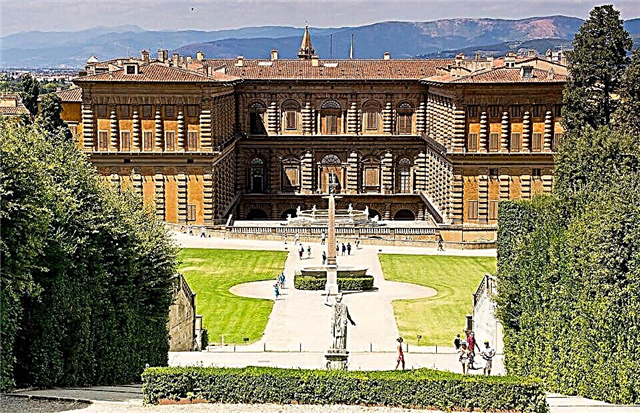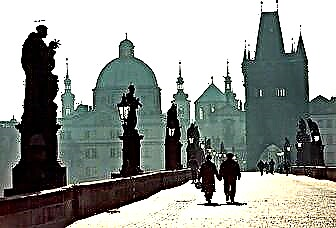Address: Greece, Athens, in the territory of the Roman Agora
Built: in the middle of the 1st century BC e.
Height: 12 m
Coordinates: 37 ° 58'27.0 "N 23 ° 43'37.1" E
Content:
Short description
In Athens, which has a long and rather complicated history, one of the most interesting architectural monuments is located, which serves as a meteorological station.
Tourists, this is unique of its kind an architectural structure made by builders from expensive marble quarried on Mount Penteli is known as the "Tower of the Winds"... In fairness, it should be noted that this beautiful and catchy name of the monument of ancient Greek architecture is not the only one: the Athenians quite often call the tower "Clepsydra" or "Aerides".

General view of the tower
In the first case, the main emphasis is on the precise hydraulic clock in the structure, and in the second, on the wind, this is how the Greek word "Aerides" can be literally translated into Russian. True, despite this "assortment of names", the meteorological tower is correctly called "Kirrist's Clock". Historical documents and chronicles that have miraculously survived to this day say that the "Tower of the Winds" was erected by the ancient astronomer Andronicus, who lived in the city of Kirra in those distant times. Like all buildings that were built before the arrival of the Savior in our world, the tower was dedicated to a pagan deity - Athena Arheged.
Surprisingly, the first tower of its kind, almost 12 meters high and just under 8 meters wide, was built in the middle of the first century BC! By the way, many modern historians put forward the opinion that the building could have been built much earlier. Unfortunately, no documents (except for various legends and ornate, confusing chronicles) confirming the exact "age" of this tower have been found to this day. The "meteorological station" of the ancient Greeks is located throughout the well-known Roman Agora and has eight faces. Each corner of the tower is strictly oriented to the cardinal point, which indicates the development of such a science as astronomy in ancient times.

View of the tower from the territory of the Roman Agora
Tower of the Winds architecture
Alas, a weather vane showing the direction of the wind and made by sculptors in the shape of a triton has not survived to this day. It is only by the upper frieze of the tower that one can judge about one of its main purposes. Each facet of the "Tower of the Winds" is dedicated to one of the eight winds that had their name in Ancient Greece... For example, on the southern edge, the architects placed the figure of the South Wind Not: it often brought the long-awaited rains, and therefore was depicted with a vessel filled with water. On the edge facing the northeast, the Kekiy wind is depicted, which generously sprinkles hail all around from its huge shield. On the western side of the most ancient "meteorological station" is a beautiful wind named Zephyr, which brought warm air masses to Greece. Perhaps that is why flowers fall from the cloak of the marble figure to the ground. The wind blowing from the north, the Greeks called Boreas, and depicted him on the tower as an ancient old man, vegetating even in warm clothes from the fierce cold. Under the figures of the winds, bringing people warm or cold, rains or hail destroying crops, there is a marking of the sundial. When the luminary rose from the horizon, the shadow falling on the dial showed the time to the inhabitants of Athens. However, as mentioned above, the clock "worked" not only from the sun, when it was hidden behind the clouds, the Athenians could find out about the time with the help of a hydraulic clock.

View of the tower from the west. Above the door is the figure of the north-west wind of Skiron, on the left is the figure of the north-west wind of Boreas
A traveler who decided to go on excursions in Athens and came to see the magnificent "Tower of the Winds", which, despite numerous wars, looting and the inexorable passage of time, has survived to this day in more or less "good" condition, will certainly be interested in the sanctuary of Athens. How could it be otherwise? In the capital of Greece, almost any attraction is associated with an ancient myth or legend.
Proceeding from this, the ancient "meteorological station", despite its purpose, simply had to have, albeit a small one, its own temple. In Greece, all architectural monuments built before our century and during the reign of the Romans were necessarily dedicated to some deity. In this case, we are talking about Athena the Archegidite. Her sanctuary stands on a platform of three steps and is a small building. On the "Tower of the Winds" you can see evidence of the former greatness of the city of Corinth - these are two small propylons of the order formed by the ancient Corinthians.

View of the tower from the south. In the center is the figure of the south wind Nota
"Tower of the Winds" - a difficult story
At a time when Christianity becomes the main religion in Greece, the "Tower of the Winds" no longer fulfills the functions assigned to it. The Byzantine priests decided that it was best to make the high tower a bell tower. As is known from history, after the Byzantines, Greece was under the yoke of the Ottoman Empire. The Turks also decided not to destroy the most ancient "meteorological station", but to make it something like Mecca. Until the Greek War of Liberation, the ancient architectural structure served as a place where Muslims offered their prayers to Allah. The "Tower of the Winds" during the Turkish domination was almost completely covered with green banners and decorated with Muslim symbols. The Turks were knocked out, and Christianity was reborn in Greece: now the "long-suffering" Clock of Kirrist is becoming a baptistery. Probably, due to its location and height, this monument of architecture and science of Ancient Greece was able to survive to our time.

Figures of winds of Ancient Greece on the sides of the tower
Restoration of an ancient architectural monument
Despite the huge number of monuments of history, architecture and culture of Ancient Greece, in a European country, work on their restoration was begun only in the middle of the 19th century. During the times when the tower was not used for its intended purpose, its base turned out to be deep underground. Archaeologists have already managed to free the unique structure from the embankment, however, it is still far from its complete restoration. In 1976, large-scale restoration work was carried out, in which highly qualified specialists were involved. True, only a few details of the building's facade were restored. The legendary hydraulic clock Klepsydru, with its pipes and complex mechanism, did not even try to start. However, thanks to the decision of the meeting of the Central Archaeological Council, which took place in Athens, work on the restoration of the water clock will begin in the very near future. By the way, you can look at an almost exact copy of the "Tower of the Winds" in…. Oxford! Its shape is completely repeated by the Radcliffe Observatory, which was built in the image of the Athenian architectural structure. By the way, its own "Tower of the Winds" also rises in the Ukrainian port city of Sevastopol.

Southeast wind figure of Apelion
Until Clepsydra began her work, and a weather vane in the form of Triton appeared above the tower, tourists can admire the beautifully executed images of the winds, the sanctuary of Athena and listen to a guide telling about the difficult story of the Tower of the Winds, which, however, is as difficult as and all over Greece. You can come to the "Tower of the Winds" in Athens and even look inside the structure every day, except for holidays. The entrance, as well as to many ancient Greek monuments, is paid.











